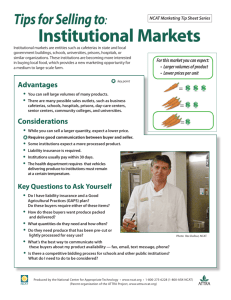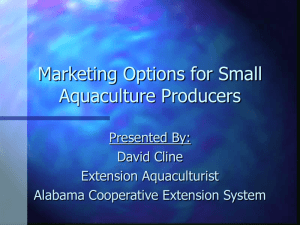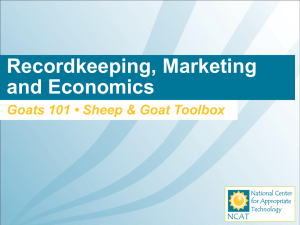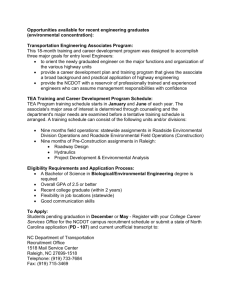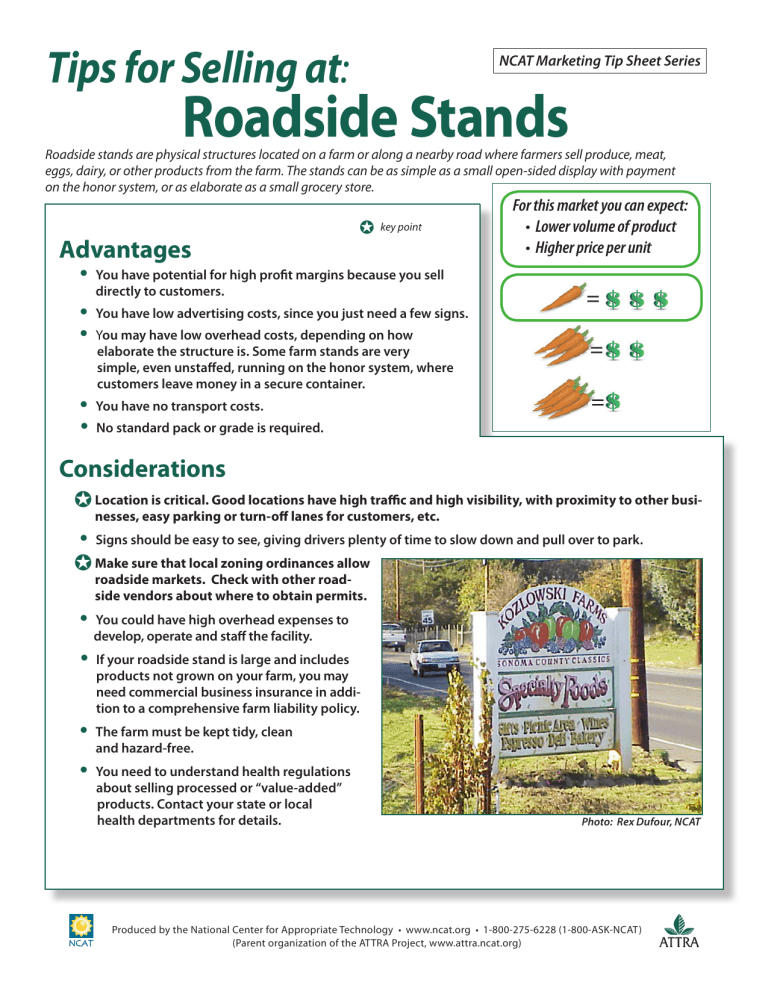
Tips for Selling at: Roadside Stands NCAT Marketing Tip Sheet Series Roadside stands are physical structures located on a farm or along a nearby road where farmers sell produce, meat, eggs, dairy, or other products from the farm. The stands can be as simple as a small open-sided display with payment on the honor system, or as elaborate as a small grocery store. Advantages J key point ou have potential for high profit margins because you sell • Ydirectly to customers. • You have low advertising costs, since you just need a few signs. may have low overhead costs, depending on how • You elaborate the structure is. Some farm stands are very simple, even unstaffed, running on the honor system, where customers leave money in a secure container. • You have no transport costs. • No standard pack or grade is required. For this market you can expect: • Lower volume of product • Higher price per unit = = = Considerations J Location is critical. Good locations have high traffic and high visibility, with proximity to other businesses, easy parking or turn-off lanes for customers, etc. • Signs should be easy to see, giving drivers plenty of time to slow down and pull over to park. J Make sure that local zoning ordinances allow roadside markets. Check with other roadside vendors about where to obtain permits. You could have high overhead expenses to • develop, operate and staff the facility. f your roadside stand is large and includes • Iproducts not grown on your farm, you may need commercial business insurance in addition to a comprehensive farm liability policy. must be kept tidy, clean • Tandhe farm hazard-free. need to understand health regulations • You about selling processed or “value-added” products. Contact your state or local health departments for details. Photo: Rex Dufour, NCAT Produced by the National Center for Appropriate Technology • www.ncat.org • 1-800-275-6228 (1-800-ASK-NCAT) (Parent organization of the ATTRA Project, www.attra.ncat.org) Key Questions to Ask Yourself J J key point D oes my location get enough traffic to generate customers? Do I have space for parking? Can I put up sufficient signs to alert drivers and give them time and room to pull off the road? • What hours and staffing would I need in order to run the stand effectively? hat licenses, permits or zoning ordinances do I need to be aware of? • WContact the state department of agriculture to find out. Resources Website. Many relevant publications and resources are offered here, such as “Entertainment Farming and • ATTRA Agri-Tourism.” Prices vary for individual publications. Many are free. An inexpensive subscription to ATTRA will give you access to all 350+ publications and databases. www.attra.ncat.org a Roadside Farm Market (2006). Agricultural Alternatives, Pennsylvania State University. 6 pp. • Developing This is a good overview of what farmers should consider when setting up a roadside stand. http://agalternatives.aers.psu.edu/Publications/ roadside_farm.pdf Regulations Expand Options. • Farmstand University of California Small Farms program. This website provides updated, California-specific information about farmstand regulations. http://sfp.ucdavis.edu/agritourism/farmstands.html Stand Marketing of Fruits and Vegetables. • Roadside This 40-page publication offers a wealth of informa- tion about marketing considerations, the shopping habits of roadside-stand customers, pricing, store layout, marketing tactics, impulse buying, popular fresh products, etc. www.caed.uga.edu/publications/2002/pdf/CR-02-09.pdf Photo: Rex Dufour, NCAT Markets, Stands, and Equipment. • Roadside Penn State offers these detailed design plans for four different sizes of roadside stands as well as a walk-in cooler. http://agmarketing.extension.psu.edu/Retail/PDFs/IP790-33.pdf Legal Guide for Direct Farm Marketing by Neil Hamilton. 1999. 235 pp spiralbound. $20.00 to $24.00. • The Before selling their products directly to consumers, all farmers should consider these important issues. Learn about legal considerations behind farmers’ markets, business organization, contracts, food stamps, advertising and marketing, land use and property law, labor and employment, insurance and liability, food processing, and marketing meat, poultry, eggs, and dairy products. for Roadside Markets. Natural Resource, Agriculture and Education Service. 1992. 32 pp. $8.00. • Facilities Valuable for persons considering a roadside market or looking to improve or expand a current one. Chapters cover site considerations (visibility and accessibility, utilities, drainage, zoning, and building ordinances); market layout (areas for sales, preparation, shipping and receiving); market structure and facilities (parking, lighting, fire protection, security). Includes illustrations and plans. www.nraes.org/nra_order.taf?_function=detail&pr_booknum=nraes-52 The development of this material was supported through USDA/NIFA/OASDFR www.outreach.usda.gov/oasdfr Tips for Selling at: Roadside Stands © 2012 National Center for Appropriate Technology—NCAT By Marisa Alcorta, Rex Dufour and Tammy Hinman, NCAT Production: Karen Van Epen This publication is available on the Internet at www.attra.ncat.org IP 426, Slot 423, Version 122612
